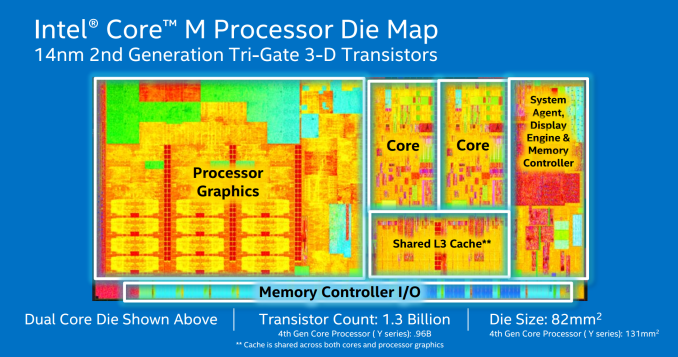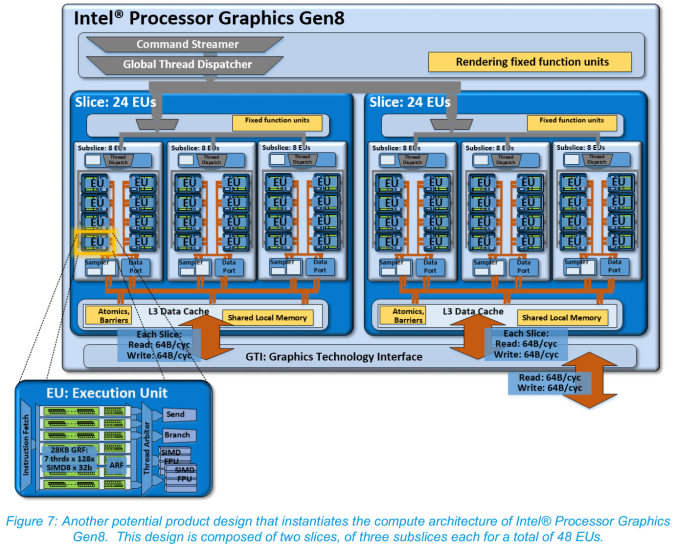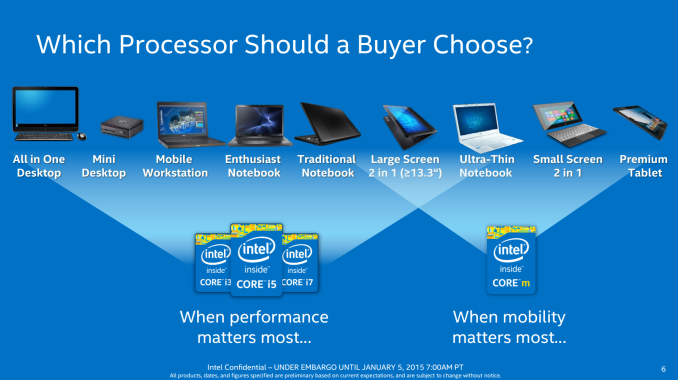Analyzing Intel Core M Performance: How 5Y10 can beat 5Y71 & the OEMs' Dilemma
by Brett Howse & Ian Cutress on April 8, 2015 8:00 AM EST
A processor architect can battle between two major opposing principles. The one most of us seem to enjoy is performance, which when taken to the extreme exhibits an all-or-nothing approach. At the other end is low-power operation which has become the main focus of the laptop and notebook market where battery capacity and density is at a premium. The position in the middle of this is efficiency, trying to extract the best of performance and power consumption and provide a product at the end of the day which attempts to satisfy both.
Of course processor architects only have control up to the point where the chips leave the fab, at which point the final product design is in the hands of OEMs, who for various reasons will have their own product design goals. It's this latter point that has resulted in an interesting situation developing around the Core M ecosystem, where due to OEM design goals we've seen the relative performance of Core M devices vary much more than usual. In our tests of some of the Core M notebooks since the beginning of the year, depending on the complexity of the test, the length of time it is running and the device it is in, we have seen cases where devices equipped with the lowest speed grades of the Core M processor are outperforming the highest speed grade processors in similar types of devices, an at-times surprising outcome to say the least.
Never content to leave things alone, we wanted to take a look at the performance in Core M in depth and how device design - particularly cooling design - can significantly impact performance. So for today we will be diving deep into Core M, to see what we can test and what can be said about system design as a whole for the mini-PC, notebook, tablet and 2-in-1 ecosystem.
Core M
First, let us loop back to the design of Core M, which historically sits in the ‘Y’ processor stack and goes by the codename Broadwell-Y. Core M only comes in dual core flavors with Hyperthreading, with an official TDP of 4.5 watts. Each model comes with 4MB of L3 cache and Intel’s 8th generation of graphics architecture under the designation HD 5300.
HD 5300 is technically a 24 execution unit design, consisting of a major slice with three sub-slices of eight execution units each. This is double the GT1 / HD (Haswell) design where Intel enables only 12 units (which has benefits when it comes to enhancing yields), or half the full GT3 implementation which keeps the same front end but doubles the major slices. A full on 48-EU design looks something like this, although Core M only has one major slice.
The three main differentiators between each of the SKUs in the Core M line are the processor base frequency, the processor turbo frequency and the integrated graphics frequency range. A number of the processors also support cTDP Up and cTDP Down modes which adjust the base frequency of the processor only. Core M supports Turbo Boost Technology 2.0 which allows individual cores of the silicon to increase in frequency within specified parameters, which may include workload, estimated current/power consumption, and temperature. These two points are key to the rest of the article.
| Core M Specifications | |||||||
| Model Number | 5Y71 | 5Y70 | 5Y51 | 5Y31 | 5Y10c | 5Y10a | 5Y10 |
| Cores/Threads | 2 Cores / 4 Threads | ||||||
| CPU Base/ Boost Frequency |
1.2 GHz 2.9 GHz |
1.1 GHz 2.6 GHz |
1.1 GHz 2.6 GHz |
0.9 GHz 2.4 GHz |
0.8 GHz 2.0 GHz |
0.8 GHz 2.0 GHz |
0.8 GHz 2.0 GHz |
| GPU Base/ Boost Frequency |
300 MHz 900 MHz |
100 MHz 850 MHz |
300 MHz 900 MHz |
300 MHz 850 MHz |
300 MHz 800 MHz |
100 MHz 800 MHz |
100 MHz 800 MHz |
| TDP | 4.5 W | 4.5 W | 4.5 W | 4.5 W | 4.5 W | 4.5 W | 4.5 W |
| cTDP Down (CPU Base) |
3.5 W 600 MHz |
No | 3.5 W 600 MHz |
3.5 W 600 MHz |
3.5 W 600 MHz |
No | No |
| cTDP Up (CPU Base) |
6.0 W 1.4 GHz |
No | 6.0 W 1.3 GHz |
6.0 W 1.1 GHz |
6.0 W 1.0 GHz |
No | No |
| Intel vPro | Yes | Yes | No | No | No | No | No |
Core vs. Atom
In general, Core M is a small departure from Intel (pun intended), bringing its main Core processor architecture, typically used for big core performance, down to power levels and chip sizes better suited for fanless laptops and tablets. Despite the drop in core counts and frequency to reach 4.5 watts, the Core M line typically has a single threaded performance advantage at this power segment as compared the competition, which is no simple achievement.
For Intel, this 4 to 5 watt TDP window for processors has typically been occupied by the Atom line of integrated SoCs. In 2014 this meant Silvermont cores in a Bay Trail system produced at the 22nm process node, but for 2015 will mean Airmont cores in a Cherry Trail system at 14nm. For most of 2014, Atom competed against high powered ARM SoCs and fit in that mini-PC/tablet to sub 10-inch 2-in-1 area either running Android, Windows RT or the full Windows 8.1 in many of the devices on the market.
Despite Intel’s initial long cadence with Atom, we are seeing them step up to the plate and provide an iterative cycle that allows for the latest node technologies combined with the updated graphics technology from the integrated Core ecosystem. Nevertheless, Intel has split this 4 to 5 watt TDP segment into two clear formats based on performance and price.
Atom sits at the lower price band ($50-$100 per chip), typically in a dual or quad core arrangement without hyperthreading and uses ‘modules’ of two discrete cores sharing an L2 cache. The integrated IO is designed to be enough for this market segment, as seen in the recently announced Surface 3, and shows that devices in the $500 region are ripe for the next Atom SoCs. Note that Braswell, which also uses Airmont cores at 14nm but goes under the Celeron/Pentium nomenclature, also sits in this 4 to 6 watt region but is aimed more at the mini-PC arena.
Intel lists all of the Core M processors at $281, and a user will be hard pressed to find a Core M device priced under $700 on the market now; such is the gap that Intel wants to strike with the two platforms. Core M sits at the heart of the new Macbook (read our hands on), as well as most of the devices in this test such as the ASUS UX305, Lenovo Yoga 3 Pro and the Dell Venue 11 Pro 7000. With the Broadwell architecture and hyperthreading under its belt, the results do speak for themselves as Core M attacks the Haswell-U line from the last 18 months in terms of direct performance.













110 Comments
View All Comments
OneCosmic833 - Friday, April 10, 2015 - link
I don't really understand, why don't the manufacturers put a little bigger heatsink with a FAN of bigger diameter into these portable devices, is it such a problem??? Production costs reduction or bad engineering? I think it would be also possible to keep the same weight if they cut some bulk mass from somewhere else of the device. Simply this throttling is not acceptable for me and an i7 should not have lower performance than i5 in sustained load...This is very very sad for us consumers, like how the manufacturers skimp us ! ! !metayoshi - Friday, April 10, 2015 - link
Great article!I'm very interested in this, though, after reading the whole article: I noticed the Asus laptop with the metal chassis was the one with the 5Y10, and the two devices that are usable as a tablet/is a tablet are the two devices with the 5Y71. However, I know that the Venue 11 Pro comes with a 5Y10 for its base configuration, so it would be interesting to see how that 5Y10 version compares vs the 5Y71 version, knowing it is thermally handicapped compared to the Lenovo, with its fan, and the Asus, which is a laptop with a metal chassis.
I was originally eyeing the Venue 11 Pro, but I jumped on the preorders of the less powerful but still capable Surface 3 with the new Atom SoC. I'm really intrigued by Core M, but all these stories of throttling and whatnot are keeping me away for now.
serendip - Friday, April 10, 2015 - link
Intel has a decent mobile chip with Atom. Core M, not so much. I would rather have a slower Atom chip that costs a lot less and can turbo for long periods than a Core M with much higher performance that isn't accessible to the user thanks to constant throttling. Maybe there should be a caveat on Core M devices like "2.4 GHz processor (for 10 seconds only), base 1 GHz". That way consumers know what they're really in for.ahfei - Tuesday, April 14, 2015 - link
Is 2.6GHz the maximum turbo speed for M-5Y71 for 2 cores, judging from the graph? Cannot find that info anywhere and some even stated the maximum 2.9GHz is for both cores!Brett Howse - Sunday, April 19, 2015 - link
I have never seen them go over 2.6 GHz for both cores. 2.9 GHz seems to be just for a single core.boe_d - Saturday, April 18, 2015 - link
I like the Sony Vaio Z approach - balls the walls hardware, fast processing power, fast storage, fast video and LIGHT. Still lighter than most laptops 5 years later and faster than many of them too! Battery power wasn't great but it had an easy to replace battery.RanBuch - Saturday, July 18, 2015 - link
I own a Lenovo yoga 3 pro. Can I configure the SoC temperature from 65°C to a higher value? I use the device as a "desktop" more often then a tablet and would love to get more juice from my machine even at the expense of the device "overheating" a little bit.HP - Wednesday, August 5, 2015 - link
These processors are perfectly decent. But at the same time, really novel due to the fact that no active cooling is required to run them. This in my view is a positive progression in CPUs together with the SoC philosophy. To have everything integrated into a smaller space. Many users might complain about performance but I bet they don't use their i5 or i7 machines to the fullest potential either. Core-M performance is perfectly decent. Granted, the only slow downs I have experienced is when compiling a Linux kernel say or running multiple FHD videos. But such tasks are run on a less than regular basis so a slight slow down in speed during these exercises is acceptable. The rest of the tasks get carried out very well in a thin, light and quiet design.Atreyiu - Tuesday, February 2, 2016 - link
I know many will disagree with me, but I am a regular user and I hate when my Venue 11 Pro 7140 (5Y10, 64 Gb, 04 Gb RAM) is heated so much that I can not put my right hand in it, that temperature is unbearable from 55 ° C upwards. Should not rise beyond what your skin can handle. This happens pretty and very quickly, then to lower spend enough time. I'm thinking let go of it and look for an alternative. I wanted a balanced team between productivity and way of life, but these temperature rises disenchanted me and the only thing that bothers me because it is fast and has no crashes or anything like that.SandraGok - Tuesday, June 9, 2020 - link
I'm not just inviting you! But it will be interesting for sure loveawake.ru